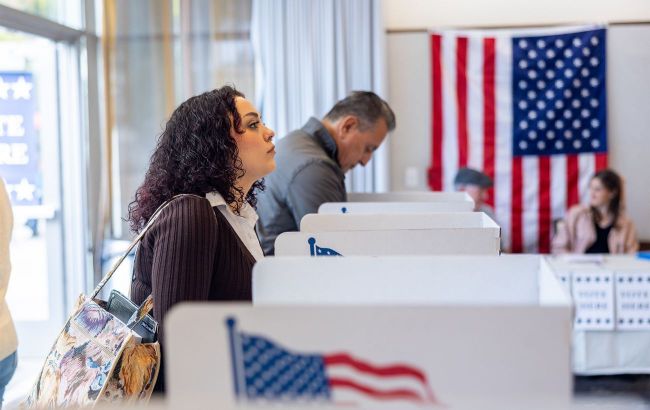Absentee voting in US: Its popularity and how it functions
 Voting in the US (photo: Getty Images)
Voting in the US (photo: Getty Images)
Many Americans vote by mail or e-mail instead of going to the polling station.
RBC-Ukraine explains how it works and why Donald Trump occasionally speculates on the topic of postal voting.
Contents
- How absentee voting works in the US
- The 2020 case – attempts to politicize absentee voting
- Absentee voting in the 2024 election
In the United States, elections occur on Tuesdays rather than on weekends, as in most other countries. Since Tuesday is a working day, many Americans do not visit polling places, opting instead to vote early and remotely — by mail and, in some states, via email.
In 2020, amid the COVID-19 pandemic, 65 million Americans voted by mail. This method of voting was chosen by twice as many Democrats as Republicans.
Among other benefits, absentee voting reduces the impact of unexpected events on voter turnout, such as bad weather. It also serves US citizens residing abroad, as polling places at US embassies and consulates do not open.
How absentee voting works in the US
Absentee voting is available in most states. However, deadlines and rules regarding who can vote this way vary.
Mail-in voting is accessible to all citizens in Maine, Maryland, Minnesota, Montana, New Jersey, New Mexico, Virginia, Washington, D.C., and, importantly, in two "swing" states, Arizona and Michigan.
Some states require an explanation of why voters cannot come to the polling place. Valid reasons include:
- Inability to access the polling place due to illness, injury, or disability;
- Being on a business trip or vacation outside the county or city of residence on election day;
- Attending college or university outside the state.
To vote by mail, one must obtain a ballot application. In some states, voters can sign up to receive ballot applications for every election, while in others, they must do so separately for each vote.
State election laws generally include a series of checks to guard against fraud. Instances of voter fraud are exceedingly rare. After receiving the ballot, the voter marks it, places it in a special envelope or pouch, and then in a separate mail envelope, signs an affidavit on the outside of the mail envelope, and returns the package by mail or in person. Additionally, ballots are printed on special paper, and all voter signatures are compared with originals in the database.
The 2020 case – attempts to politicize absentee voting
The uniqueness of mail-in voting may tempt candidates to speculate on the subject. In the 2020 presidential election, many voters voted by mail. Most of these votes went to Joe Biden, as Donald Trump claimed in the lead-up to the election that mail-in voting would lead to widespread fraud.
Several problematic instances and errors with mail-in ballots were identified during the election. For instance, about 400 mail-in ballots in Michigan listed the incorrect vice-presidential candidate for Trump — Jeremy Cohen of the Libertarian Party instead of Mike Pence.
In Wisconsin, mail containing several ballot applications was found in a ditch near Greenville. In Pennsylvania, nine discarded ballots filled out by military personnel were discovered, seven of which, according to the US Department of Justice, were for Trump. However, these were isolated incidents that did not impact the election results, as the percentage of violations was minimal.
After the election, Trump, evidently unwilling to acknowledge defeat, sought to contest, among other things, mail-in voting. However, most lawsuits were dismissed.
Data from the United States Elections Project indicates that 7 million more Democrats voted by mail in the 2020 election than Republicans. However, this reflects more those voters who would not have turned out at polling places on election day.
Long before those elections, American analysts warned that a "red mirage" effect would occur during the counting, as votes cast on election day would be counted first, giving the Republican candidate ("red") a clear advantage. However, as mail-in votes, predominantly cast by Democrats, began to be counted, this advantage would dissipate. Nonetheless, the fact that Trump's lead over Biden dwindled as the vote count progressed provided the Republicans with further grounds to assert that the election was stolen.
Absentee voting in the 2024 election
In the 2024 election, Trump’s stance is contradictory. He claims both the danger of fraud with mail-in ballots and recommends mail-in voting.
Meanwhile, in recent months, his campaign team has actively promoted mail-in voting. Trump campaign staff help voters register for ballots, and large screens at rallies display messages urging Trump supporters to request mail-in ballots and update their registration details.
Compared to 2020, fewer people plan to vote by mail in this year's elections. In states that do not send ballots by mail to all voters, the number has decreased by 58% compared to 2020.
The decline is particularly significant in the "swing" states of Georgia and North Carolina, which dropped by 84% and 75%, respectively. This is partly due to damage caused by Hurricane Helen, but the largest urban areas in both states were largely unaffected. Requests for mail-in voting have decreased by 59% in Wisconsin, 36% in Pennsylvania, and 24% in Michigan. Due to the relatively lower popularity of mail-in voting in this election, it is reasonable to expect that votes will be counted faster than four years ago.
Earlier, RBC-Ukraine reported on which celebrities and public figures support presidential candidates in the US.
Sources: the official US government website, publications by the New York Post, ABC News, and The Guardian.

